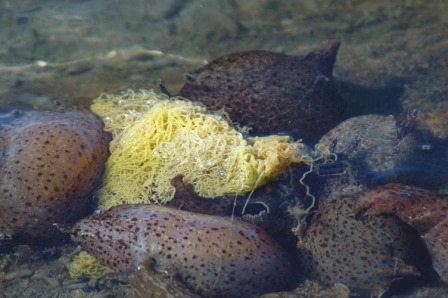
Photo credit: Larry Fukuhara
The sea hare is not a rabbit, not even close, it’s actually a sea slug. But thanks to two tentacle-like extensions on the top of its head that stick up like rabbit ears, it was dubbed the sea hare.
This photo features the California brown sea hare or Aplysia californica. Up-close, sea hares look like big slimy loosely defined blobs, but this massive slug body contains some very interesting characteristics.
For starters, sea hares are hermaphroditic, meaning each animal is both male and female. There is a penis just to the right of the mouth and a vagina in the center of the back. Pretty awesome.
Despite having the reproductive convenience of two genders in one body, sea hares still mate with each other to bring forth the next generation, which is probably a smart move genetically speaking. To facilitate mating, sea hares form a circle and then each animal inseminates the one in front. This group sex event has been dubbed a “Roman circle.” (If anyone knows the background on the “Roman circle” name, please contact me.)
The eggs look like a mass of tangled spaghetti, as you can see in the photo. And while the lifestyle of sea hares may not be legal in the U.S., it’s an effective system, with one sea hare producing 500 million eggs during one season!
I will leave you with that thought. Stay tuned for more on sea hares in the next post!
Found one that looked pretty well identical on a beach in Bowen, Queensland, Australia.